|
The Kiev Salyut/Zenith 80/Kiev 80/Kiev
88
Can the
Novoflex Bellows for the Hasselblad 1600F and
1000F be used with these cameras?
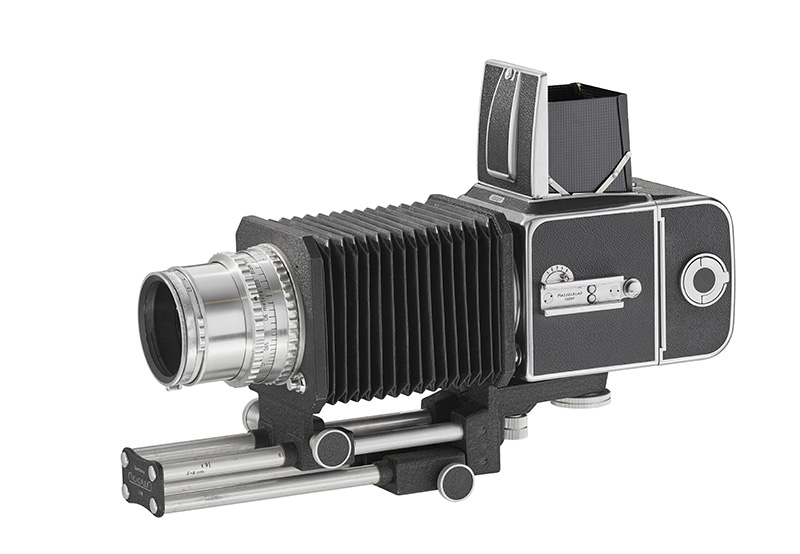
Novoflex bellows on a Hasselblad 1000F camera
Photograph courtesy of Martin Grahl of Novoflex
[1000Balgen_001.jpg]
The original Hasselblad was launched in 1949, and
the camera was given the revised name “Hasselblad
1600F” in 1953, when the Hasselblad 1000F was
launched. (See Nordin, 1998, p. 17.)
Hasselblad ceased the production of the 1600F and
the 1000F in 1957 when they launched the Hasselblad
500C, which abandoned the focal-plane shutter of the
previous two cameras and used instead lenses that
had a shutter built into them.
However, 1957 was the year that the
Arsenal factory in Kiev launched its “clone” of the
Hasselblad 1600F and 1000F, the “Salyut”. This
originally had a top speed that was claimed to be
1/1500 sec, although, like Hasselblad, they
discovered that accurately achieving such a high
speed was difficult, and so the top speed was
reduced to a nominal 1/1000 sec.
With fairly minor modifications, this camera evolved
to become the Kiev 80 and then the Kiev 88. In
some markets there were various other brand names,
such as “Zenith 80” in the U.K. in the 1970s (see Spillman, 1971, pp
72-73) and “Revue 6×6”, then “Revue-80”
for cameras marketed by Foto-Quelle in Germany (the
Revue-80 from 1971, see Princelle, 2004, p.
222). It would appear that the Kiev 88 may
still have been in production at the beginning of
the 21st century. Or it may just be that
unsold stock manufactured before the collapse of the
Soviet Union, or shortly after then, was still being
sold.
I state elsewhere (here) that to
the best of my knowledge, no bellows were
manufactured for these Soviet-era clones of the
original focal plane Hasseblad cameras.
However, Novoflex manufactured bellows for the
Hasselblad 1600F and 1000F, and it may be
that these bellows can be mounted on the Arsenal
cameras named on this page.
In fact, writing to me in July 2020, Martin Grahl
of Novoflex told me, “Since the early Hasselblad
1000F/1600F and the Kiev 88 share the same mount,
it's quite likely, that this camera can be
attached to the Novoflex-made bellows for the
Hasselblad 1000F.”
I am grateful to Martin for the picture above and
for most of the pictures and further information
on this that I reproduce below.
Martin reports:
“These bellows have no rear bayonet,
which would otherwise have prevented the
photographer from removing the camera
afterward. You'll notice that the camera's
bayonet release knob almost fouls the rear
standard. Thus Novoflex came up with this
rather unusual solution of mounting a camera
to a bellows.
“You'll notice a tongue-like
prolongation of the rear standard, that
attaches directly to the camera. The camera is
being slid onto an aluminum ring on the rear
standard and is secured from underneath by 2
screws.”
The original Novoflex drawing below
shows this more clearly.
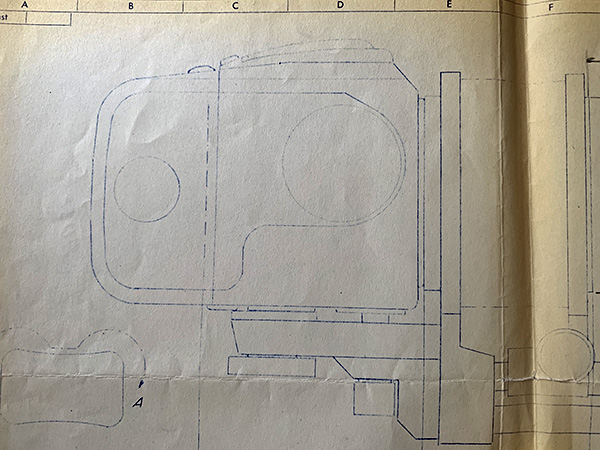 [1000Balgen_003.jpg] [1000Balgen_003.jpg]
|
|
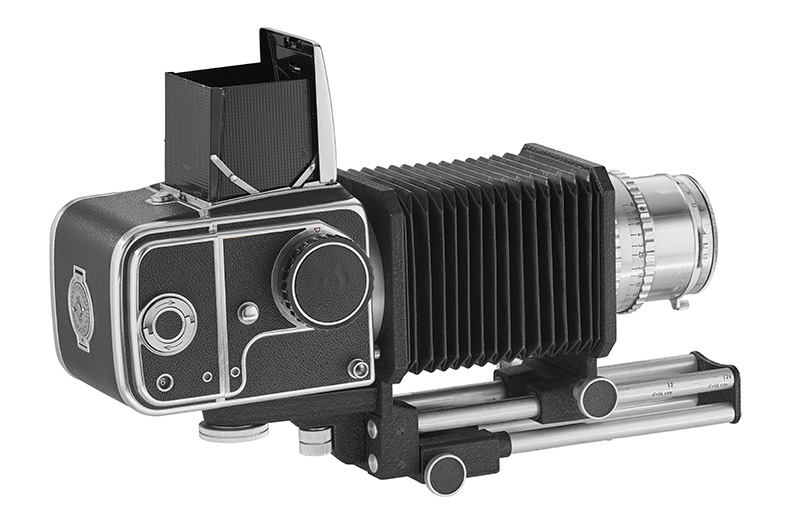
A Hasselblad 1000F with the Novoflex bellows
designed for it
Photograph courtesy of Martin Grahl of Novoflex
[1000Balgen_002.jpg]
Drawing to the left courtesy of Martin
Grahl of Novoflex
|
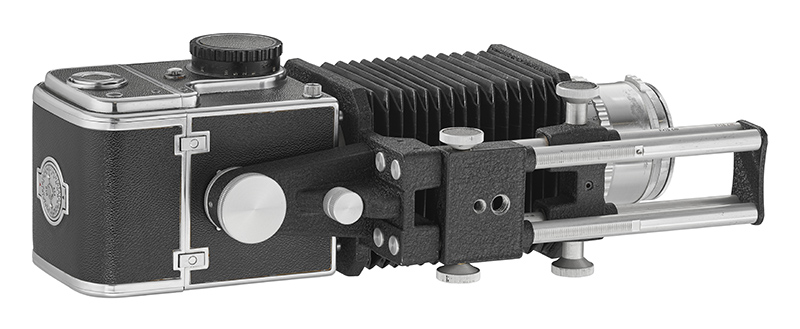
[1000Balgen_004.jpg]
|
|
This photograph
of the underside makes the assembly easy to
understand.
Martin tells us, “These bellows were available
for only a year in 1953.”
Martin continues:
“Since
the early Hasselblad 1000F/1600 and the ...
Kiev 88 share the same mount, it's quite
likely, that this camera can be attached to
the Novoflex-made bellows for the Hasselblad
1000F. I've yet to find out if this really
works, and if the thread distance between the
2 tripod threads on the camera's base is the
same.”
Photograph
courtesy of Martin Grahl of Novoflex
|
The second
version of the Novoflex bellows for Hasselblad
Martin tells us what happened
next:
“The long-lasting collaboration
between Hasselblad and Novoflex began in 1954.
From that point on, Novoflex bellows for
Hasselblad cameras were available through
Hasselblad only, carrying the Hasselblad-logo,
as well as a Karl Müller, Memmingen marking.” (Karl Müller was the founder
of Novoflex, and Memmingen is the town where
Novoflex was and still is located.)
“When
Hasselblad decided, to have its bellows made
by Novoflex, it also slightly redesigned the
bellows, by moving the camera to the other
side and atop the bellows rods. This also
meant it had to extend the camera mount to
enable photographers to detach the camera.
Naturally, this does increase the minimum
bellows extension.”
To the right we show a Novoflex drawing of the
period, showing the new design detail.
In his book “Hasselblad Compendium Revised” of
2011, Richard Nordin shows (on p. 70) a good
view of the rear of the first Novoflox
bellows, as well as a picture of the revised
bellows that connected to the camera in the
standard way via a mounting screw thread as
used on the lenses.
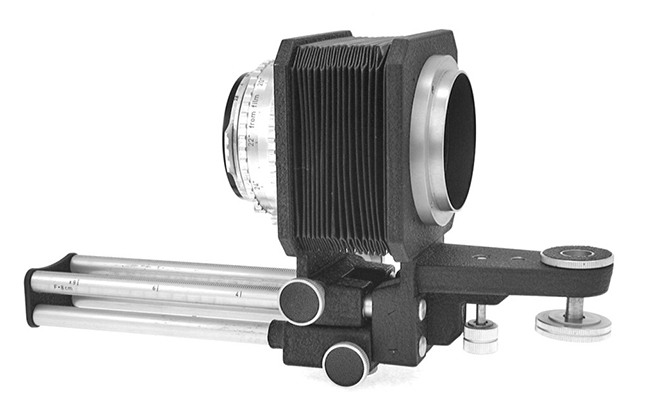
The first bellows manufactured by
Novoflex for use with the Hasselblad
1600F and 1000F cameras. It is
clear that there is no screw mount or
bayonet mount on the section that is
inserted into the throat of the camera.
[NovBell_1.jpg]
My thanks to
Richard Nordin for supplying
higher-resolution copies of these
two photographs and the one below
and for his
permission to reproduce them
here.
|
|
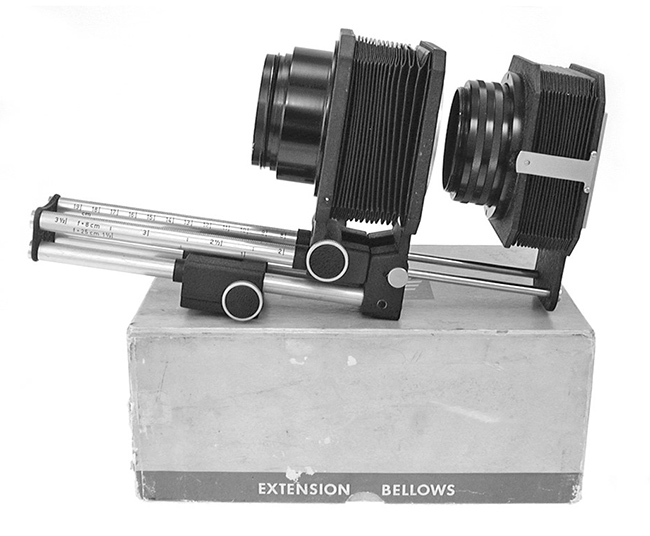
In the revised version (shown here with
the slide-copying attachment), the new
tube at the back of the bellows can be
seen.
[NovBell_2.jpg]
|
|
|
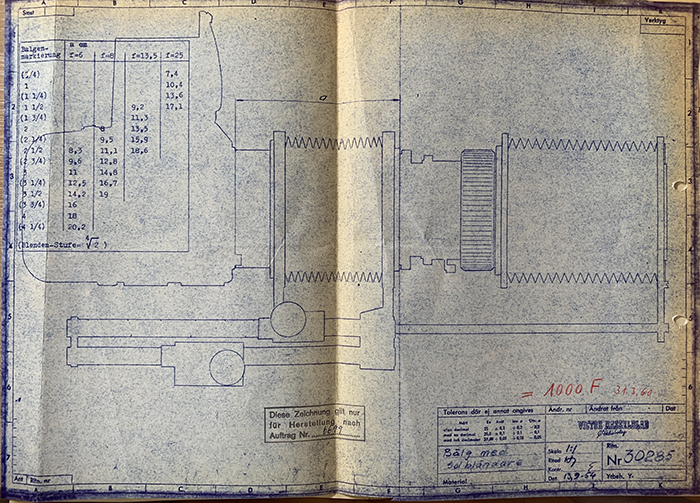
Drawing
courtesy of Martin Grahl of Novoflex
[1000Balgen_005.jpg]
|
In both of his books, Nordin also shows the newer
bellows on a Hasselblad 1000F. Here we show the
picture that appears in his Revised edition of 2011.

[NovBell_1000F.jpg]
|
|
The newer design
of the Novoflex bellows for the Hasselblad
1000F. Here it is easy to see that the
lens release button on the front of the camera
body is now easily accessible, because of the
tube section at the back of the bellows.
Picture received from
Richard Nordin, 2020.
|
Bibliography
for this page
Nordin, Richard, “Hasselblad System
Compendium”, Small Dole, West Sussex: Hove Books,
1998
Nordin, Richard, “Hasselblad Compendium Revised”,
North Saanich, BC, Canada: Cloak Hill Communication,
2011
Princelle, Jean Loup, “The Authentic Guide to
Russian and Soviet Cameras, Second Edition”,
Ondreville sur Essonne, France: LE REVE EDITION,
2004
Spillman, Ronald, “Discover Rewarding Photography:
The Manual of Russian Equipment”, London: Technical
& Optical Equipment (London) Ltd, 1971
|

 [1000Balgen_003.jpg]
[1000Balgen_003.jpg]




